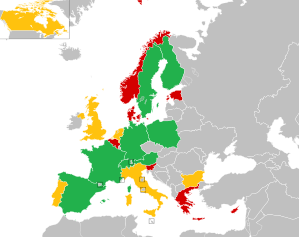Eurovision Young Dancers 1993
| Eurovision Young Dancers 1993 | |
|---|---|
| Dates | |
| Final | 15 June 1993 |
| Host | |
| Venue | Dance House, Stockholm, Sweden [1] |
| Presenter(s) | Anneli Alhanko and John Chrispinsson [1] |
| Host broadcaster | Sveriges Television (SVT) |
| Website | youngdancers |
| Participants | |
| Number of entries | 15 |
| Debuting countries | |
| Returning countries | |
| Non-returning countries | |
| |
| Vote | |
| Voting system | A professional jury chose the finalists and the top 3 performances |
| Winning dancers | |
The 5th Eurovision Young Dancers Competition final was held in Stockholm, Sweden on June 15, 1993.
Although the number of countries remained 15, there were many changes, since 4 countries took part for the first time (Poland, Estonia, Slovenia and Greece) and Austria returned, but 5 countries withdrew (Portugal, Netherlands, Italy, Bulgaria and Yugoslavia).
As it happened in 1989 and 1991, a semifinal was held to choose the finalists. The semifinal took place 2 days before the final (13 June 1993).
Format
The format consists of dancers who are non-professional and between the ages of 16–21, competing in a performance of dance routines of their choice, which they have prepared in advance of the competition. All of the acts then take part in a choreographed group dance during 'Young Dancers Week'.[3]
Jury members of a professional aspect and representing the elements of ballet, contemporary, and modern dancing styles, score each of the competing individual and group dance routines. Once all the jury votes have been counted, the two participants which received the highest total of points progress to a final round. The final round consists of a 90-second 'dual', were each of the finalists perform a 45-second random dance-off routine. The overall winner upon completion of the final dances is chosen by the professional jury members.[3]
Jury Panel
 Nils-Åke Häggbom (Head of Jury)
Nils-Åke Häggbom (Head of Jury) Birgit Cullberg
Birgit Cullberg Frank Andersen
Frank Andersen
 Gigi Gheorghe Caciuleanu
Gigi Gheorghe Caciuleanu
 Paolo Bortoluzzi
Paolo Bortoluzzi Peter Van Dyk
Peter Van Dyk María de Ávila
María de Ávila Heinz Spoerli
Heinz Spoerli Micha Van Hoecke
Micha Van Hoecke Pierre Lacotte
Pierre Lacotte Elsa-Marianne Von Rosen
Elsa-Marianne Von Rosen Elisabetta Terabust
Elisabetta Terabust Jorma Uotinen
Jorma Uotinen
Participant countries
| Pos | Country | Name |
|---|---|---|
| - | Rafaella Raschella | |
| - | Lia Haraki | |
| - | Julie Strandberg & Mads Blangstrup | |
| - | Stanislav Jermakov & Luana Georg | |
| - | Riina Laurila | |
| - | Raphaëlle Delaunay-Belleville | |
| - | Theodora Bourbou | |
| - | Kristine Oren | |
| - | Anna Sasiadek & Jacek Bres | |
| - | Kusha Angst | |
| - | Ursa Vidmar | |
| - | Zenaida Yanowsky | |
| - | Ludde Hagberg | |
| - | Jens Weber & Franziska Koch | |
| - | Gregor Hatala |
Winners and Remaining Finalists
| Pos | Country | Name |
|---|---|---|
| 1 | Zenaida Yanowsky | |
| 2 | Kusha Angst | |
| 3 | Gregor Hatala | |
| Raphaëlle Delaunay-Belleville | ||
| - | Riina Laurila | |
| - | Jens Weber & Franziska Koch | |
| - | Anna Sasiadek & Jacek Bres | |
| - | Ludde Hagberg |

